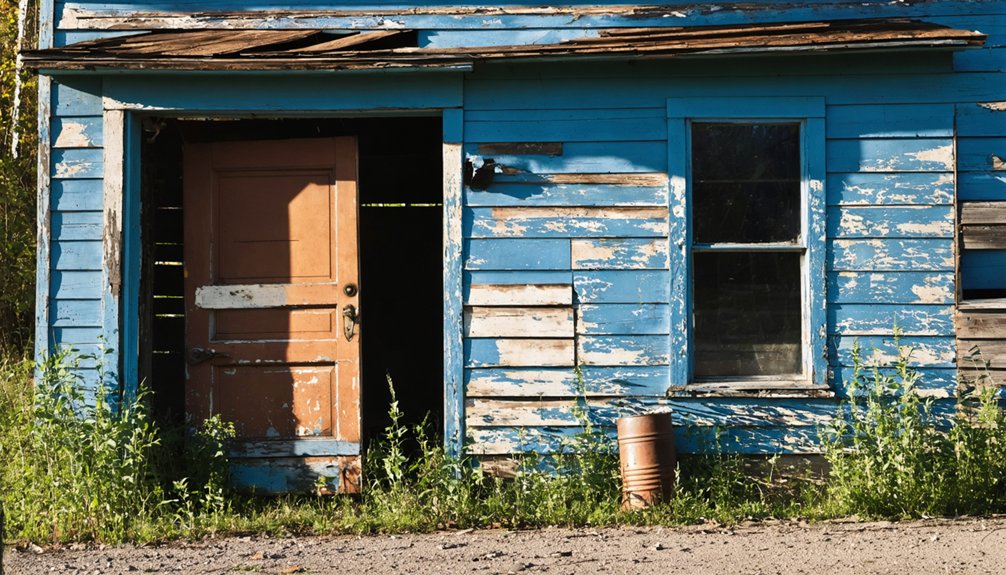You’ll find Bear Gulch nestled in South Dakota’s Black Hills, where Custer’s 1874 gold discovery sparked a mining boom. This frontier settlement thrived from 1878 to 1903, complete with a post office, mining operations, and a close-knit community of prospectors and their families. Today, weathered remnants tell stories of daily life, from ore processing mills to miners’ cabins, while the old cemetery chronicles the harsh realities pioneers faced in this Black Hills boomtown.
Key Takeaways
- Bear Gulch began as a Black Hills gold mining boomtown in 1874 following Custer’s expedition and discovery of gold deposits.
- The town established a post office in 1878 and thrived through mining operations until its decline by 1903.
- Various mining techniques were used, including placer and lode mining, with a significant 200-foot adit supporting local infrastructure.
- Remnants include ore processing mills, mine hoists, miners’ cabins, and the Bear Gulch Cemetery with pioneer headstones.
- Economic challenges, mine flooding, and a devastating mill fire in the 1950s led to Bear Gulch’s eventual abandonment.
The Rise of a Black Hills Mining Community
In 1874, the discovery of gold by Custer’s Expedition ignited a rush of prospectors into the Black Hills, leading to Bear Gulch‘s establishment as one of several boomtowns in the region.
You’d have found early gold discoveries concentrated along the creek beds, where prospectors quickly staked their claims and set up mining operations to extract placer gold from the loose gravel and soil.
As mining techniques evolved, you would’ve witnessed the transformation from simple placer mining to more sophisticated hard-rock operations.
The establishment of a post office in 1878 marked Bear Gulch’s growth into a proper mining community.
With successful gold discoveries continuing to draw settlers, the town developed essential infrastructure to support the growing population of miners seeking their fortunes in the Black Hills’ rich mineral deposits.
Like many mining communities, Bear Gulch’s growth occurred on land that was protected under the Treaty of Fort Laramie, leading to tensions with the Sioux people.
The area’s mining operations expanded significantly after the discovery of the Homestake Mine in 1876, which influenced development throughout the Black Hills region.
Life in Early Bear Gulch
You’d find daily life in Bear Gulch centered around the demanding routines of mining work, with families tending to basic chores like hauling water, chopping wood, and maintaining their hastily constructed wooden homes.
Social bonds formed through gatherings at taverns and social halls, where miners and their families would meet for dances and community events between work shifts. The discovery of gold in 1874 triggered waves of miners to establish settlements like Bear Gulch throughout the Black Hills region.
The harsh realities of frontier living meant dealing with primitive sanitation, limited water supplies, and the constant threat of fire in the closely packed wooden structures that made up this Black Hills mining settlement.
Daily Routines and Chores
Life in Bear Gulch revolved around the demanding routines of mining and domestic survival. You’d start your day with mining duties – panning for gold, digging shafts, or prospecting the rugged Black Hills terrain. Miners often transported their findings to exchange gold dust as currency at local businesses.
Equipment maintenance was constant, from repairing sluice boxes to maintaining ore carts.
Daily chores consumed the rest of your time. You’d haul water from springs, chop wood for your cast iron stove, and preserve food through smoking or salting to survive the harsh winters.
Family roles were clearly defined – men typically worked the mines while women managed households and children. Kids pitched in too, fetching water and gathering firewood.
The community worked together to maintain streets, prevent fires, and keep shared spaces clean. Subsistence gardens and small livestock helped supplement food supplies from trading posts.
Community Social Activities
Despite the hardships of frontier life, Bear Gulch residents found ways to gather and unwind through various social activities. The local saloons served as hubs for community gatherings, where you’d find miners sharing stories about their latest prospecting adventures over drinks. Popular establishments like Sudden Death and Scandalous Bills drew regular crowds of workers and townspeople. Similar to the mining communities that emerged after 1875, Bear Gulch developed a vibrant social scene around its mining operations.
You could enjoy bluegrass and folk musical performances during these get-togethers, often accompanied by dancing and games. Community spirit thrived through potluck meals, where families shared food and strengthened social bonds.
You’d find entertainment in outdoor activities like swimming in Bear Butte Creek or joining group hikes through the Black Hills. During winter months, card games and indoor socials kept the community connected.
The one-room schoolhouse doubled as a meeting place, while religious services and cultural celebrations maintained traditions brought from settlers’ diverse backgrounds.
Living Conditions and Housing
While miners rushed to stake their claims in Bear Gulch, housing started with basic log cabins and wooden shacks hastily built from local timber. You’d have found these early living spaces cramped and rudimentary, with wooden shingle roofs sometimes covered in tar paper or tin for better waterproofing.
Inside, you’d rely on wood stoves for warmth during harsh Black Hills winters, while oil lamps and candles provided dim lighting. Living near the post office until 1903, residents could maintain vital connections with the outside world.
As the town grew, mining companies built uniform worker housing during the early 1900s tin mining boom. Living spaces remained challenging, with limited plumbing and unreliable water sources from nearby streams or wells.
Housing materials were basic, offering little protection from the elements, and most structures lacked proper insulation. You’d share tight quarters in boarding houses or family dwellings, often with multiple relatives or lodgers.
Mining Operations and Economic Growth
As prospectors discovered gold in Bear Gulch‘s streams during the 1870s, the area quickly transformed into a bustling mining district that would later diversify into tin production.
You’d find miners using various mining techniques, from simple panning to more advanced cyanide processing implemented by the Gold Eagle Mining Company in the early 1900s.
The mining boom sparked the growth of supply towns, with Bear Gulch serving as an early hub before Tinton’s establishment in 1903.
One major operation included a 200 foot adit that supported the area’s mining infrastructure.
While mining created jobs and supported local businesses, including mercantile stores, banks, and schools, economic fluctuations made success challenging.
The tin mining ventures particularly struggled, producing less than 5 tons despite significant investment.
Market instability and declining production eventually led to the area’s downturn, with many operations shuttering by mid-century.
Notable Families and Early Settlers
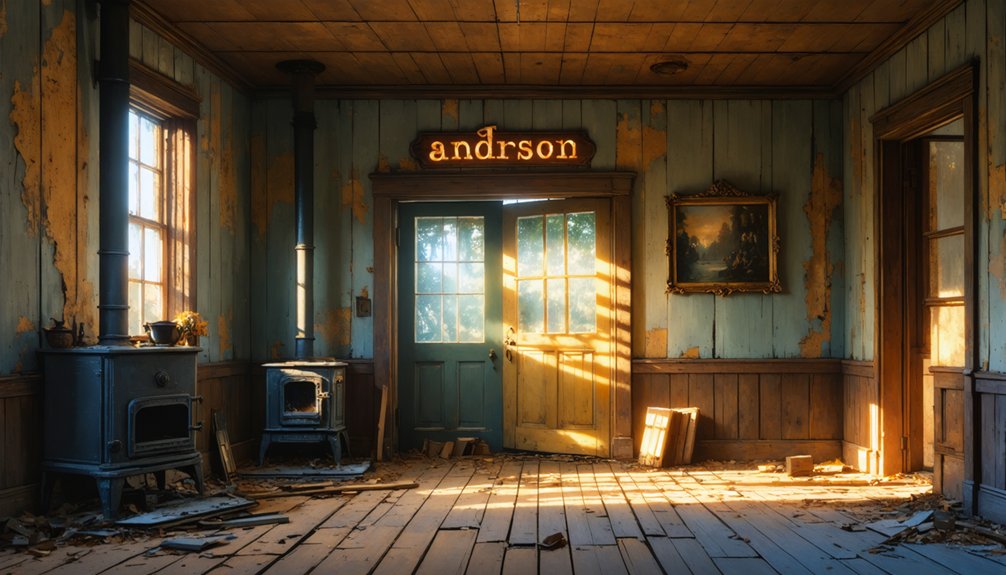
If you visit Bear Gulch’s historic cemetery today, you’ll find the Bonebright family plots tell stories of the area’s earliest pioneer life through their detailed headstone inscriptions.
The records show pioneer families like the Youngs and Johnsons established deep roots in the community during the late 1870s, with many serving in crucial civic roles. In fact, Clarence Johnson served as one of Brown County’s first commissioners after breaking ground in the region.
Daily glimpses of settler life emerge through preserved letters and documents, revealing how these families survived harsh winters and developed the region’s first farms along strategic river crossings.
Pioneer Bonebright Family Legacy
Among the notable pioneers who shaped Bear Gulch‘s early development, the Bonebright family established a significant presence through their commercial enterprise and community involvement.
The family’s roots trace back to Andrew Jackson Bonebright and his wife Mary Jane Meeker, whose Bonebright genealogy includes three documented children: John Nelson, Amanda Katherine, and Carrie Arminta.
You’ll find evidence of their family dynamics in the strategic placement of their shop, which operated adjacent to John Hough’s home, serving the needs of local miners and settlers.
When Mary Jane died near the Spearfish goldfields around 1884, the family persevered, continuing their crucial role in Bear Gulch’s commerce.
Their legacy endures through historical records, cemetery documentation, and their contribution to the town’s economic backbone. Today, the Bear Gulch Cemetery stands on private property, preserving the history of these early settlers.
Cemetery Records Tell Stories
The Bear Gulch Cemetery stands as a silent chronicle of the town’s pioneer history, with its weathered headstones and family plots telling rich stories of early settlers.
You’ll find tombstone stories etched in stone, revealing the harsh realities of frontier life through inscriptions of miners, farmers, and tradespeople who shaped this Black Hills community.
The cemetery’s layout reflects strong family connections, with close-knit burial plots showcasing the area’s mainly Euro-American settler heritage.
You can trace the town’s development through detailed epitaphs and dates ranging from the late 1800s through early 1900s.
Many markers indicate the challenges these pioneers faced, from high infant mortality to mining accidents, while others display proud affiliations with fraternal organizations and religious symbols that defined their frontier society.
Settler Daily Life Glimpses
Life in Bear Gulch revolved around the mining cycles that drew settlers to this Black Hills outpost between 1878 and 1903. You’d have found prospectors and their families working long days, panning for gold in the local streams or laboring in the tin mines. Their settler traditions centered on survival and mutual support in this remote frontier environment.
Daily life meant rising early to handle mining tools, whether at placer claims or in company operations. You’d have visited the Bear Gulch post office to collect mail and exchange news, while relying on nearby Tinton’s mercantile for supplies.
Families shared resources and labor, creating a tight-knit community where everyone knew the rhythm of mine shifts and the importance of working together to overcome the challenges of frontier living.
Architectural Remnants and Historical Sites
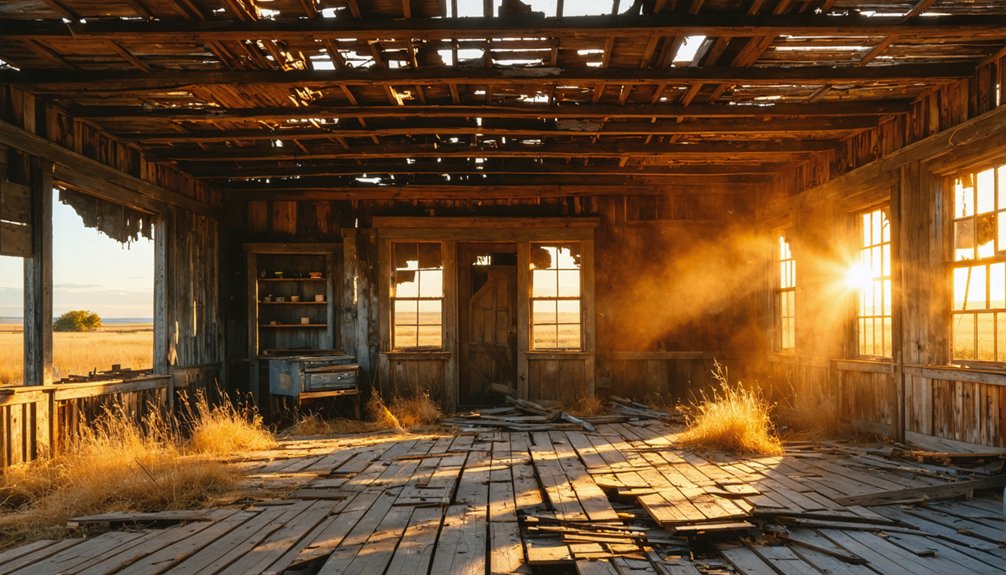
Standing as silent witnesses to South Dakota’s mining heritage, Bear Gulch‘s architectural remnants paint a picture of frontier industrialism through their weathered frames and crumbling foundations.
You’ll find ore processing mills, mine hoists, and scattered miners’ cabins throughout the site, their architectural decay telling stories of the town’s bustling past. Log-built structures and stone foundations dot the landscape, while surviving chimneys stand like sentinels among fallen timbers.
Rusted machinery and weathered cabins whisper tales of frontier dreams, while stone chimneys guard memories of Bear Gulch’s golden age.
As you explore, you’ll notice tailings piles and slag heaps marking former mining operations, while roofless homes and workshop ruins reveal the historical significance of this Black Hills settlement.
The site remains largely untouched by preservation efforts, letting nature slowly reclaim these authentic traces of frontier life, from simple residential structures to industrial processing facilities.
The Bear Gulch Cemetery
Hidden among overgrown brush in Lawrence County’s rugged terrain, Bear Gulch Cemetery serves as a poignant memorial to the mining community‘s frontier settlers.
You’ll find this historic burial ground near the ghost town site at coordinates 44.38193, -104.03299, on private property in North Lawrence’s unorganized territory.
The cemetery’s significance extends beyond its weathered stones, telling the story of Bear Gulch’s mining era through:
- The grave of Mary Jane Meeker Bonebright (d.1884), representing the families who shaped this frontier community
- Physical evidence of the harsh realities faced by 19th-century mining settlements
- A reflection of the boom-and-bust cycle that defined many Black Hills communities
Today, minimal maintenance and restricted access have left the cemetery in a natural state, much like other ghost town burial grounds throughout the region.
The Decline of Mining Activity
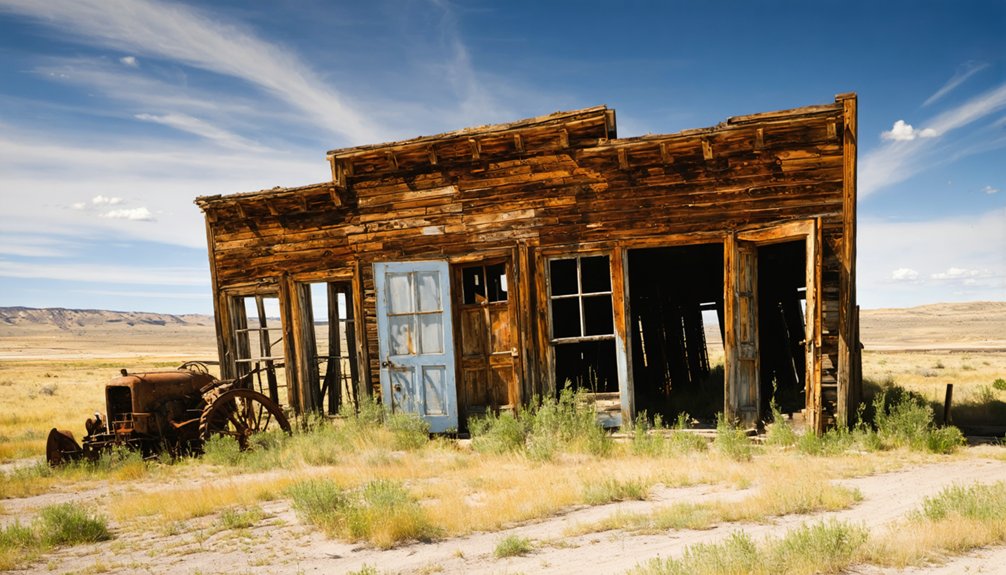
As Bear Gulch shifted from placer to lode mining in the 1880s, the once-thriving mining community began its slow descent into abandonment.
You’d have witnessed dramatic economic impacts as floods damaged placer infrastructure in 1883, forcing miners to change from independent prospecting to wage labor in mechanized operations.
The mining changes proved challenging, with companies like Gold Eagle and Scotland Mining struggling against market volatility and overoptimistic mineral assessments.
By 1903, mine flooding and economic depression forced many operations to close. While tin mining near Tinton briefly flourished until 1911, production steadily declined.
A devastating mill fire in the 1950s nearly emptied the area. The final blow came in the 1990s when regional mining giant Homestake dramatically reduced its workforce and production, marking the end of Bear Gulch’s mining era.
Preservation Challenges and Private Land Status
While Bear Gulch holds significant historical value, its location on private land creates substantial preservation hurdles.
These ownership implications severely limit public access and complicate efforts to protect the site’s remaining structures from deterioration.
The most significant preservation obstacles you’ll find at Bear Gulch include:
- Restricted access due to private property laws, preventing historical documentation and research
- Exposure to harsh Black Hills weather conditions that accelerate structural decay
- Limited state and federal involvement in preservation efforts due to private ownership status
Without public funding or coordinated preservation initiatives, Bear Gulch’s historic buildings continue to face environmental damage and neglect.
The site’s protection relies heavily on private landowner decisions, creating an uncertain future for this piece of Black Hills mining heritage.
Legacy in Black Hills History
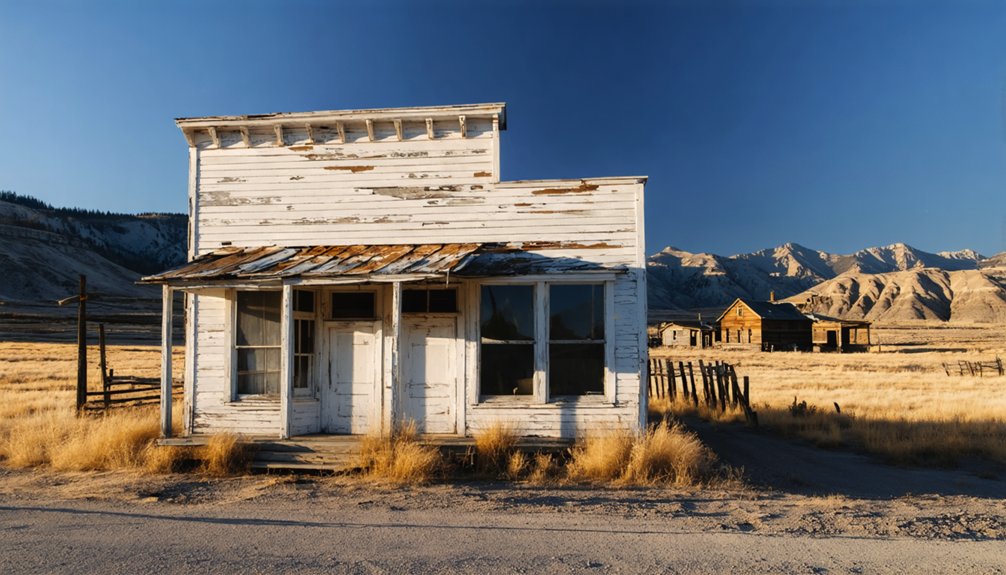
Despite its current preservation challenges, Bear Gulch stands as a tribute to the complex mining history of the Black Hills region. You’ll find its 25-year post office operation and adoption of mining technology like cyanide processing reflected the area’s evolution from temporary camps to established settlements.
The site’s legacy extends far beyond its mining days, connecting to the region’s rich indigenous heritage. As part of Pahá Sápa, the sacred Black Hills of the Lakota people, Bear Gulch’s story intertwines with centuries of Native American presence that preceded the mining boom.
The town’s rise and fall mirrors broader patterns of resource extraction in the Black Hills, where company towns flourished and faded based on mineral markets, leaving behind physical reminders of this transformative period in Western expansion.
Frequently Asked Questions
Are There Any Reported Ghost Sightings or Paranormal Activity at Bear Gulch?
You won’t find documented ghostly encounters at this private property. While nearby Black Hills towns boast paranormal investigations and spirit sightings, there aren’t any confirmed reports from Bear Gulch itself.
What Wildlife Species Currently Inhabit the Abandoned Bear Gulch Area?
You’ll find diverse wildlife including badgers, mule deer, bald eagles, beavers, and mountain goats thriving around the abandoned structures. The area’s species diversity reflects successful wildlife conservation efforts in the Black Hills.
Was Bear Gulch Ever Connected to Other Towns by Railroad?
You’d think a bustling mining town would’ve had rail service, but Bear Gulch’s railroad history shows no direct connections. Locals had to use wagons or stagecoaches to reach nearby rail-served towns.
What Was the Peak Population of Bear Gulch During Its Heyday?
You’ll find that precise population dynamics remain uncertain, but based on historical significance and comparisons to similar Black Hills mining camps, Bear Gulch likely peaked at several hundred residents during its heyday.
Were There Any Notable Crimes or Lawlessness Recorded in Bear Gulch?
You won’t find many unsolved mysteries or historic crimes documented in this town. While Black Hills mining camps often saw lawlessness, specific records of criminal activity in Bear Gulch remain particularly scarce.
References
- https://www.sdpb.org/rural-life-and-history/2023-08-21/some-black-hills-ghost-towns-and-their-origins
- https://www.historynet.com/ghost-town-tinton-south-dakota/
- https://www.sdhspress.com/journal/south-dakota-history-2-2/some-black-hills-ghost-towns-and-their-origins/vol-02-no-2-some-black-hills-ghost-towns-and-their-origins.pdf
- https://www.southdakotamagazine.com/watson-parker-ghost-town-friends
- https://www.blackhillsbadlands.com/blog/post/old-west-legends-mines-ghost-towns-route-reimagined/
- https://blackhillsatvdestinations.com/bear-gulch-cemetery/
- https://www.sdhspress.com/journal/south-dakota-history-11-1/booming-the-black-hills/vol-11-no-1-booming-the-black-hills.pdf
- https://en.wikipedia.org/wiki/List_of_ghost_towns_in_South_Dakota
- https://westernmininghistory.com/towns/south-dakota/tinton/
- https://www.americanhistorycentral.com/entries/black-hills-gold-rush/
